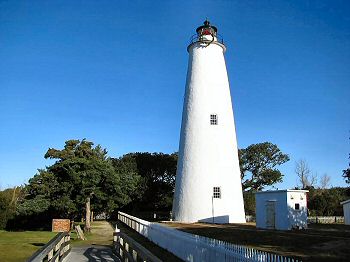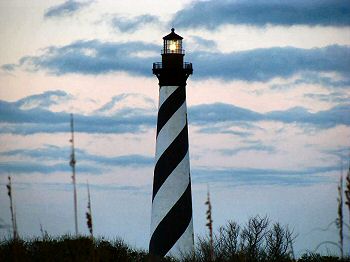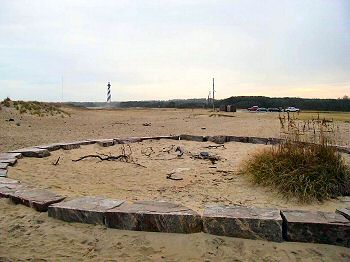|
(12-2007)
Enlarge
Of all the early North Carolina lighthouses, the Bodie Island Lighthouse
had the rockiest beginnings. Disagreements over the location delayed the
building of the first lighthouse for ten years. After one year, one side
was a foot lower than the other causing the lamp to stop functioning;
attempts to prop up the lighthouse were unsuccessful. So, in 1859 a
90-foot-high brick tower was built as a new Bodie Island Lighthouse. In
the early years of the Civil War, this lighthouse was controlled by Union
troops. However, in 1861, Confederate troops slipped into the lighthouse
and blew it up
 Bodie
Island Light Station: National Park Service Bodie
Island Light Station: National Park Service
Outer Banks Black Out. As the Civil War
began, Confederate forces on the Outer Banks of North Carolina began to
stop the lighting of the lighthouses along the coast to hinder the Union
navy. Union concern grew as privateering and pirating began on Federal
ships in that area. The first campaign on the Carolina's coast began on
Hatteras Island and Forts Clark and Hatteras |
|
(12-2007)
Enlarge
The Ocracoke Lighthouse is the oldest active lighthouse in North Carolina.
The current 76-foot-tall Ocracoke Lighthouse, located in the fishing
village of Ocrocoke on Ocracoke Island, replaced the first Ocracoke
Lighthouse which was a 55-foot-high, wooden structure. The original
lighthouse was struck by lightning in 1818 and burned down. The 1823
lighthouse was controlled by both northern and southern troops during the
Civil War. Confederate troops removed the lens from the lamp in the early
years of the war, while Union troops replaced it in 1863. The fuel used to
light the lanterns behind the lens was, first, whale oil, then kerosene,
and finally electricity
 Ocrocoke
Island Light Station: National Park Service Ocrocoke
Island Light Station: National Park Service |
|
(12-2007)
Enlarge
The Cape Hatteras Lighthouse is the tallest lighthouse in America. Located
to warn travelers off shore in the area known as the "Graveyard of the
Atlantic," the lighthouse has 268 steps inside to the top. During the
Civil War, the lighthouse was attacked by both Union and Confederate
forces. Over the years, three different Cape Hatteras Lighthouses have
existed. The current lighthouse is actually the second structure. In 1936,
it was so threatened by sea erosion that it was replaced by a steel
skeleton tower in nearby Buxton Woods. The erosion reversed by 1950,
however, so the tall brick lighthouse was reactivated
The present lighthouse was built in 1870 although the
Civil War era lighthouse was on the same spot. The current lighthouse was
moved further inland in 1999
 Cape
Hatteras Light Station: National Park Service Cape
Hatteras Light Station: National Park Service |
|
(12-2007)
Enlarge
Lighthouse keepers dwelling: Then and current picture (Cape Hatteras)
|







